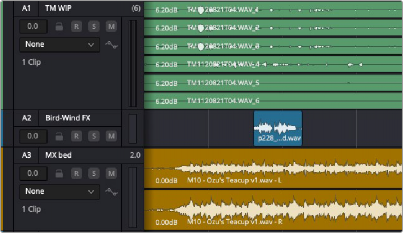
< Previous | Contents | Next >
Each audio track in a DaVinci Resolve timeline corresponds to a single channel strip on the Mixer’s left side. Depending on how an audio track has been configured, each audio track is assigned a specific audio format, such as mono, stereo, 5.1 or 7.1 surround, or Dolby Atmos. Track routing allows multiple audio channels within the clips on a track to be correctly routed to the proper audio output for monitoring and rendering via the lanes that can be seen within each track on the Fairlight timeline.
Audio tracks in DaVinci Resolve often contain multiple channels from a given clip, but how those individual audio channels are displayed depends on the page:
— The Cut and Edit pages display a single clip “lane” per audio track in the Timeline, regardless of how many channels the clips on that track are representing. The waveform displayed is a composite, showing a mix of the various channels within the clip.
— This can make it easier to work with multichannel tracks without the distraction of viewing multiple channel lanes, which could make things look a lot “busier.” However, the tradeoff is that detailed activity on any of the various channels on that track are not seen.
— The Fairlight page displays the same number of tracks as the Edit page, but each track on the Fairlight page is divided into lanes, which shows each individual channel of a clip’s audio. This additional visual information can help with editing and mixing.



![]()
(Top) 6 channel and stereo audio in the Cut and Edit pages represented by single composite tracks. (Bottom) The same audio in the Fairlight page shows the six channel and stereo tracks with multiple lanes that correspond to each of the file types.